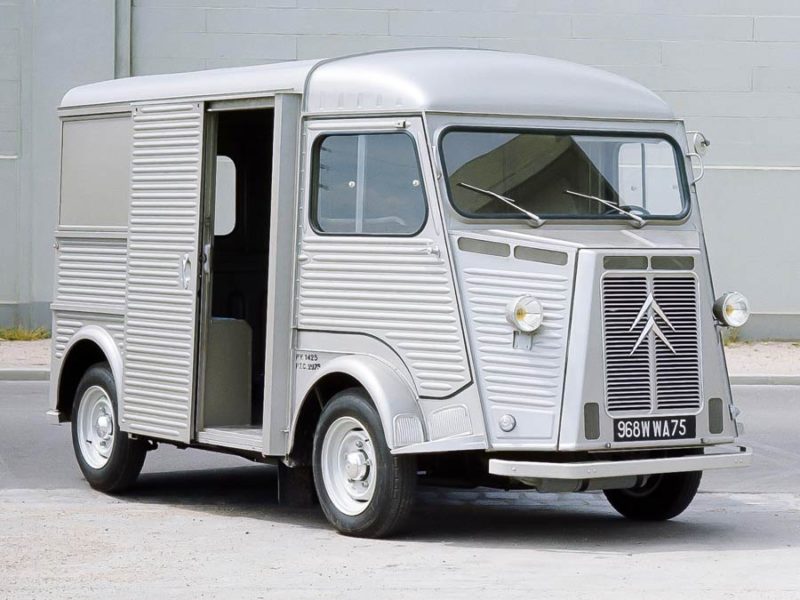De Citroën Type H was the legendary delivery van of Citroën and made use of many existing and already proven Citroëncomponents. The Type H was presented in 1947 as the successor to the front-wheel drive – and developed with the Traction Avant among other things – TUB.
Also the first new post-war Citroën made use of the now experienced Traction Avant technique. And the construction of the Type H was a piece of constructive ingenuity. Most of the technical applications were located at the front. This made it easy to adapt the functional part – say behind the front seats – and to set it up for the uses for which the entrepreneur, institution or holiday maker uses the Citroen Type H bought. The buyer also had the advantage of a flat loading floor – due to the lack of a cardan shaft. The Type H had various model names, which depended on the payload. During its construction period, the full front orderer from France was available as HY, HZ, H1200 and 1600.
Many possibilities
From the XNUMXs it became possible to simply extend the chassis. Also the structure of the Citroën Type H could be adapted in various respects to the wishes of the customer. It could be raised and extended. In addition, an additional sliding door could be fitted and options were offered to equip the sides with folding side flaps. At an earlier stage (the fifties) came Citroën already with a Pickup version. And in the later years of construction, an ambulance was built with hydropneumatic spring system at the rear. The signature for this special version was set by the Dutch coachbuilder Ackermann.
Different engine variants
During the construction period of the HY, the traditional French orderer was available with different engines. In the beginning, the 11 CV (1911 cc) variant was supplied in the Citröen HY, an engine that was temporarily replaced in the 9s by the variant with 1628 fiscal horsepower. This 1966 cc engine made way for the 1911 cc engine in XNUMX. Citroën from 1961, however, also made use of diesel engines, and with that an important market wish was met.
Almost unchanged during production years
The power of the Citroën Type H was that he went through life almost unchanged in profile. Citroën only made minor changes. The oval rear window was replaced by a larger one in the 1963s. The characteristic split window at the front disappeared in 1964, the interior changed slightly (from 6 the Type H got the Ami 1969 dashboard) and the lighting also changed slightly. In XNUMX it was banned in the Benelux and later also in Switzerland for safety reasons to supply the Type H with suicide front doors. In the XNUMXs, Citroën improve her classic orderer.
De Citroën Type H
From 1947 to December 1981, the Citroën Type H was built and in that period he built up his image thanks to the many ridges in the design and the many possibilities for use. It's not for nothing that Citroën 473.289 managed to sell units of this special delivery van.
Also read:
- What advantages you have as a subscriber
- 100 years Citroën. The company car history. Part One
- 100 years Citroën. The company car history. Part 2 (slot)
- Mercedes MB 100 D: Rarer than a big AMG
- VW bus and Ford Transit ... van is coming soon










Two heavy horses in it, trailer behind it and only drive with three gears and 1900 cc petrol. You were happy when you reached 80 km/h after a very long acceleration period. And the necessary noise from the engine in the cabin.
The diesel version was a big improvement.
And nice as a camper with a sawn 2CV borrowed behind it in the same color.
Old soldiers never die, because they are still popular.
The Moving Barn.
And so ugly that it is actually very beautiful.
Great car!
Actually has Citroën built four icons: the Traction Avant, this H-series, the 2CV TPV and the ID/DS (the rest are derivatives and/or further developments of course).
Masterfully designed this orderer and that already in the 40s.
Very annoying and extremely unfair that that sad VW bus is so much more popular than this one Citroën. The H was/is so much better, in every way.
The advantage of that 'irritating' VW bus is that the HY is therefore still somewhat affordable!
Still, I think I like the first types of VW bus T1. Driven all the way to the Iranian border with a T2 in HTS time, it was 20 years old
The milkman who used to visit my parents' house had an H. I can still hear him and know what he looked and smelled like inside.
The winters used to be harsher than now. As young rascals it was always the sport to throw snowballs into his moving shop through the open rear right door.
We also got one back. Man, what exactly could that milkman throw! We were happy. So is the milkman! And he also apparently had fun with his Citroën H because he really drove it for years.
Nice story Maurice